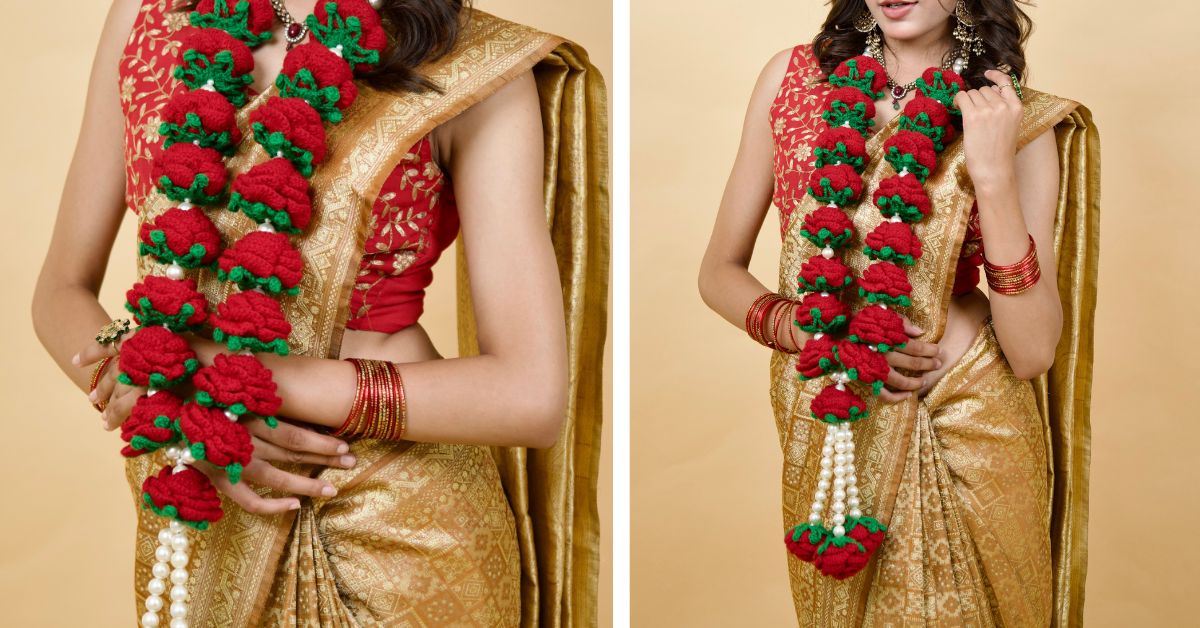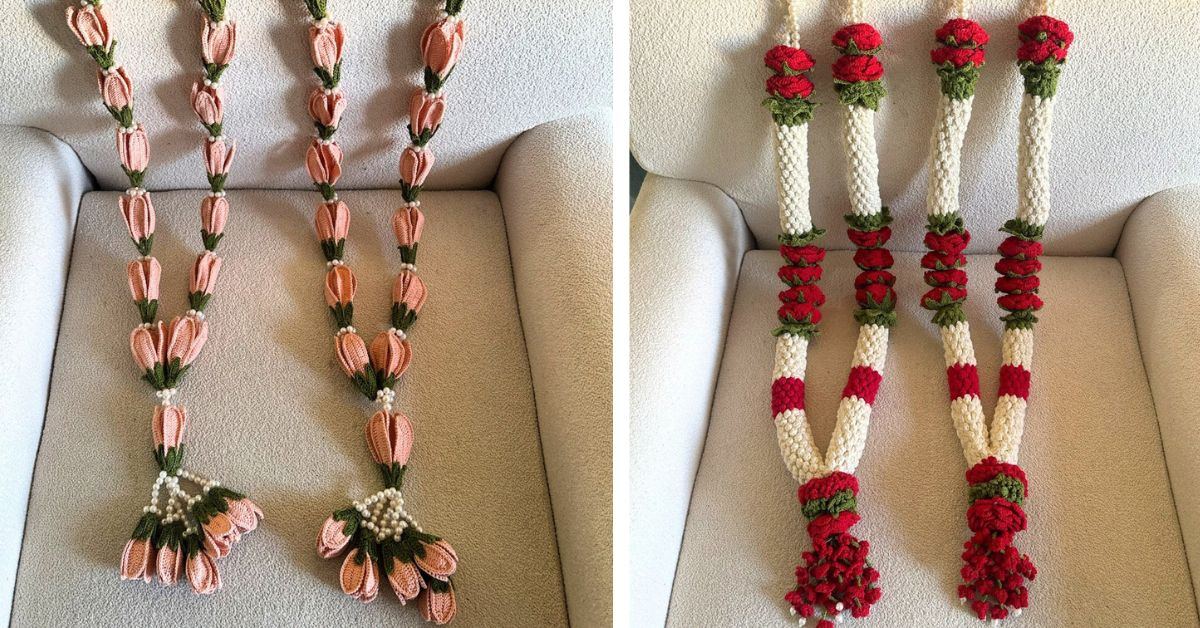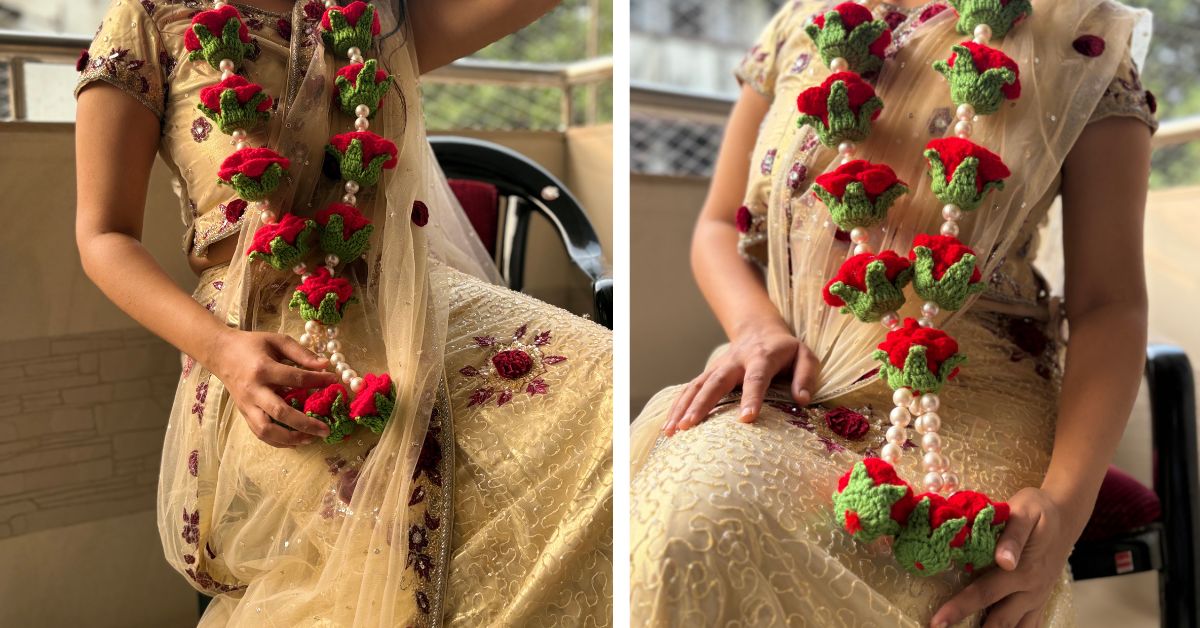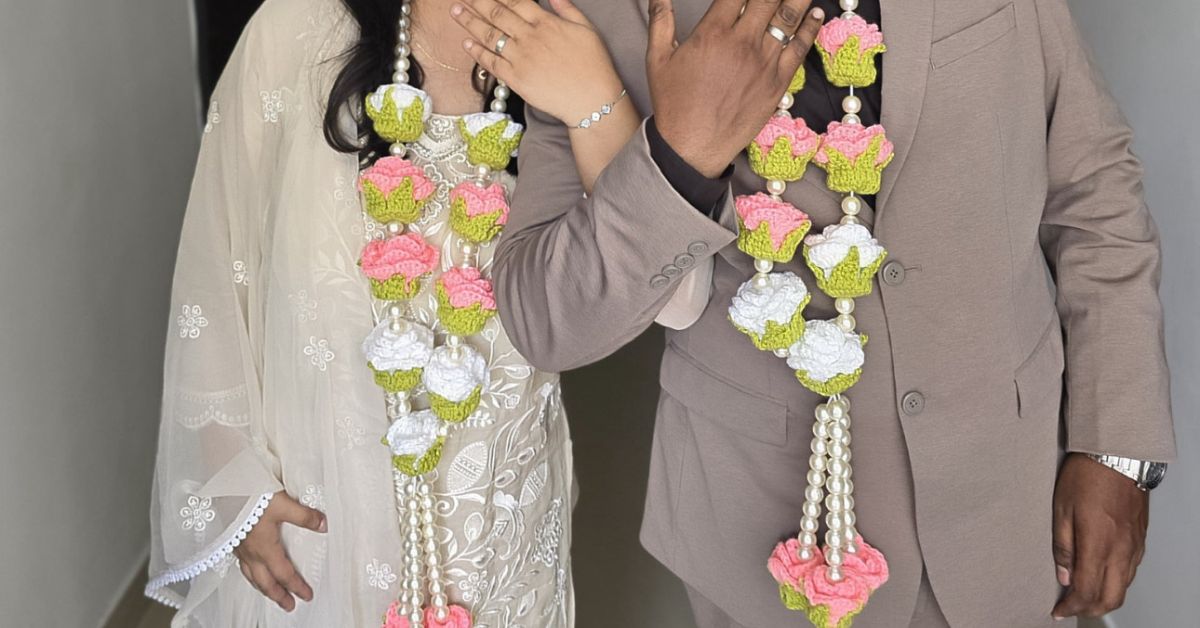Crochet ‘Varmalas’ Turn Wedding Garlands Into Sustainable Keepsakes — Would You Begin Your Pheras With Them?
Feature image courtesy: Gul Jaipur
If you had told an Indian grandmother 10 years ago that her crochet hook would one day become a wedding essential, she might have laughed you out of the living room. Crochet was supposed to belong to sweaters, cushion covers, and slightly lopsided dolls that nobody wanted to wash.
Yet, in 2025, this humble hook-and-yarn craft has made its way into the centre of one of the most symbolic wedding rituals: the varmala.
Now imagine this: instead of tossing your varmala into the compost bin, you hang it on your bedroom wall, frame it like art, or even pass it down like an heirloom. No dried petals, no smell of fading roses, just soft, colourful yarn flowers, stitched lovingly by hand.
Crochet varmalas are turning one of India’s oldest wedding rituals into something playful, sustainable, and ever so slightly Pinterest-worthy.
Yes, you read that right. The sacred garland exchange, long dominated by fresh roses, marigolds and orchids, is now being reimagined in cotton yarns, pearl beads, and pastel threads. Crochet varmalas are the new stars of sustainable weddings, and they are fast gaining ground with couples who want a keepsake that lasts far beyond the pheras.
From Instagram feeds to destination weddings, this handcrafted alternative is being embraced by brides and grooms, who are looking for something personal, unique, and environmentally conscious.
But how did this trend, equal parts quirky and sentimental, take root?
 A stunning creation by Enchanted Threads, founded by Ananya Malhotra. Image courtesy: Enchanted Threads
A stunning creation by Enchanted Threads, founded by Ananya Malhotra. Image courtesy: Enchanted Threads
A garland that never wilts
For Ananya Malhotra, founder of Enchanted Threads, the idea sprouted from a simple observation. “People were already preserving their varmalas in resin art. I thought, why not preserve the entire thing instead of just parts of it?” she says.
At first, the concept raised eyebrows. Could yarn really replace the fragrance and grandeur of roses?
“The response was mixed,” Ananya admits. “Some people loved the concept of forever sustainable varmalas, whereas others still preferred fresh flowers because of their elegance. It took time for people to warm up, but now we’re seeing far more queries compared to last year.”
Much of this surge, she explains, comes from the diaspora.
“Mostly, the NRIs are really loving the concept. It has this delicate, niche quality and connects them back to their heritage. They also appreciate the custom options, different flowers, pearls, and colour schemes, which allow them to personalise in a way fresh flowers often can’t.”
A single crochet varmala takes between 14 to 20 hours to complete, depending on the design. The process begins with careful planning: the right flower size, the right colours, the right balance of pearls and embellishments. Once the prototype is approved, her team of 25 underprivileged women artisans from Uttarakhand gets to work.
Tanya Setia’s Gul is another powerhouse of sustainability where beautiful crochet varmalas take shape. “Each piece is a work of art that embodies the beauty of rural India and the passion of our women artisans. We at Gul Jaipur are firm believers in the virtues of conscious living,” says Tanya. “We work closely with our women artisans to guarantee that they receive their much-deserved recognition and working conditions while creating our products using their learned skill sets,” she adds.
 Tanya Setia’s Gul is another powerhouse of sustainability where beautiful crochet varmalas take shape. Image courtesy: Gul Jaipur
Tanya Setia’s Gul is another powerhouse of sustainability where beautiful crochet varmalas take shape. Image courtesy: Gul Jaipur
“It’s not production that’s the issue,” Ananya explains. “The challenge is timelines. Because this trend is still new, couples often place orders just a week before the wedding. Customisation takes time, and since it’s for their special day, it has to be absolutely perfect.”
Beyond sentiment, Ananya also points to the sustainability argument. Fresh flowers often travel from different parts of India or even internationally, requiring refrigeration and transport. Crochet alternatives, she says, cut down this carbon footprint significantly.
“It’s a better way forward. Fresh flowers end up in the garbage within hours. Crochet varmalas can be priced in the same range, and you can keep them forever,” she shares.
A lockdown hobby turns into forever memories
For 18-year-old Manya Jain of Knot Kisses, the journey to crochet varmalas began in her bedroom during the 2020 lockdown. She was barely 13 when she picked up a hook because she wanted new clothes and her mother refused to buy them. What started as a rebellion became a craft, and then a calling.
“I taught myself entirely through YouTube,” she recalls. “My grandmother used to crochet, and I was always fascinated. With time, I fell in love with the process.”
The leap from fashion accessories to wedding garlands came unexpectedly. At a Delhi event where she had set up a stall, a bride-to-be asked if she could make crochet varmalas for her wedding.
“That moment was really special,” Manya smiles. “I’d always imagined making one for my own wedding someday. To actually craft one for someone else felt surreal.”
Her process is deeply collaborative. Couples share references, colours, themes, and even the mood they want to create. Manya sketches five or six design options, balancing length, floral motifs, and detailing before she begins crocheting. “I undid my first varmala three times before it felt right,” she laughs.
Each pair takes about four to five hours to craft. Basic designs with a single string of flowers and beads start at Rs 3,500, while customised versions can go up to Rs 9,500 or more.
Couples can choose not just the colours and flowers, but also add small personal details. “One couple wanted their college colours included because that’s where they fell in love,” she says, adding, “That’s the beauty of crochet, you’re not just saving flowers, you’re saving a moment, a story, a piece of love stitched by hand.”
Sustainability plays a role here too. Manya prefers cotton yarn for its lightness and comfort, and she often upcycles beads or embellishments from old jewellery.
Social media has been her biggest stage. “I started by posting crochet work online. Consistency, sharing behind-the-scenes, connecting with people, that’s how orders came in. Now, there’s a steady stream of queries, especially for crochet varmalas. It hasn’t gone viral overnight, but it has grown steadily.”
A keepsake that is full of soul
For Zainab Mukhtyar, crochet varmalas are about intimacy and permanence. “Traditional varmalas are lovely, but they fade away within hours. With crochet, you can preserve that special moment. It’s a keepsake that couples can hold on to, just like their memories,” she says.
 Zainab’s crochet brand focuses on the emotional value of each varmala. Image courtesy: Zain’s Story
Zainab’s crochet brand focuses on the emotional value of each varmala. Image courtesy: Zain’s Story
Unlike Manya, Zainab’s idea didn’t come from a specific request. It was born out of her own reflections on weddings and memory. “It wasn’t one moment. It was just the thought that you could preserve your special day in a more meaningful way. That’s how I began curating crochet varmalas.”
The response, she says, has been steadily growing. “It didn’t take off immediately, but now I get new queries almost every day.” Each varmala takes two to three days to make, depending on the number of flowers and the design. She uses acrylic yarn and adds beads to bind the flowers together.
For Zainab, the appeal lies in the emotional value. “Nothing goes to waste. The flowers don’t wilt. It’s handmade with love and care, and it’s something couples can keep forever. I feel weddings are moving towards more sustainable, mindful choices, and crochet varmalas fit right into that. The best part is how sentimental they are and full of soul.”
Why crochet, why now?
The rise of crochet varmalas says a lot about how Indian weddings are evolving. Once notorious for their extravagance and waste, younger couples are increasingly seeking ways to make their celebrations more personal and sustainable.
“I’m always on the lookout for fresh trends and styles, so when I came across crochet varmalas, I found them incredibly cute — something that could create a buzz at my wedding,” says 26-year-old Shilpa, who tied the knot in 2024.
“I ordered white mogra-like flowers with an additional layer of crochet roses, and the whole piece cost me around Rs 4,300. The varmala is now framed in my living room, and it’s the best thing to see when I wake up every day,” she adds.
 For couples mindful of their carbon footprint or eager for keepsakes, crochet varmalas offers a way out. Image courtesy: Zain’s Story
For couples mindful of their carbon footprint or eager for keepsakes, crochet varmalas offers a way out. Image courtesy: Zain’s Story
Fresh flowers, while undeniably beautiful, come with hidden costs, including environmental, financial, and emotional. Hours of refrigeration, long-distance transport, and thousands of rupees spent on garlands that last barely an evening. For couples mindful of their carbon footprint or eager for keepsakes, crochet offers a way out.
There is also a revivalist charm to it. Crochet, once dismissed as a “grandmother’s hobby”, is now at the forefront of slow fashion and handmade crafts. It carries a nostalgia, a tactile softness, and a sense of intimacy that mass-produced items lack.
And then there is the Instagram effect. A pastel crochet varmala against a cream sherwani or a red lehenga makes for striking visuals, fuelling curiosity and desire among wedding planners and couples alike.
Behind the crochet varmalas are not just designers, but entire communities of women artisans. At Enchanted Threads, Ananya ensures 30 percent of the proceeds go directly to her team of underprivileged women in Uttarakhand. For Manya, it has been about collaboration with fellow crochet artists, slowly expanding from a solo effort to a small creative team. For Zainab, it’s about pouring herself into every detail, bead by bead.
Each varmala carries within it not just threads and knots, but also stories of empowerment, patience, and love.
The challenges are real. Tight timelines, lack of awareness, the lingering preference for fresh flowers, but so is the promise.
With more media coverage, rising interest among NRIs, and the growing demand for sustainable wedding practices, crochet varmalas are no longer just a niche experiment. They are becoming part of the mainstream wedding vocabulary.
The rise of crochet varmalas is not happening in isolation; it mirrors a larger shift towards conscious weddings across India. Couples are increasingly swapping paper-heavy invitations for seed-paper cards that sprout into plants, replacing plastic-heavy décor with biodegradable alternatives, and even turning to upcycled fabrics for their wedding outfits.
Seen against this backdrop, crochet varmalas become more than just a pretty keepsake, they are part of a powerful movement that redefines how we celebrate love, proving that tradition and sustainability can go hand in hand.
Couples can frame them, pass them down, or simply keep them folded away, soft with yarn and memory. In a wedding culture obsessed with grandeur, crochet varmalas remind us of something simpler yet profound.
Love, after all, is meant to last. Why shouldn’t the garlands?
News